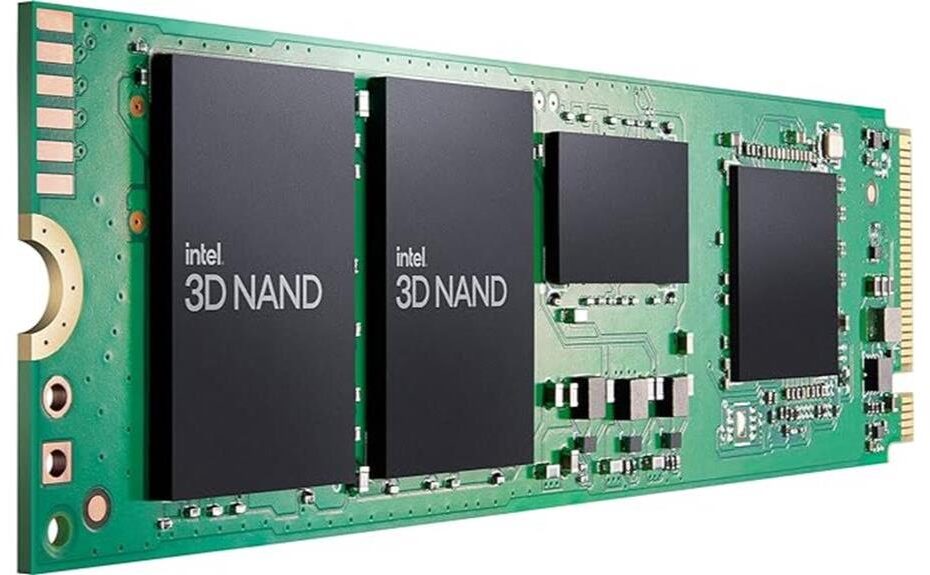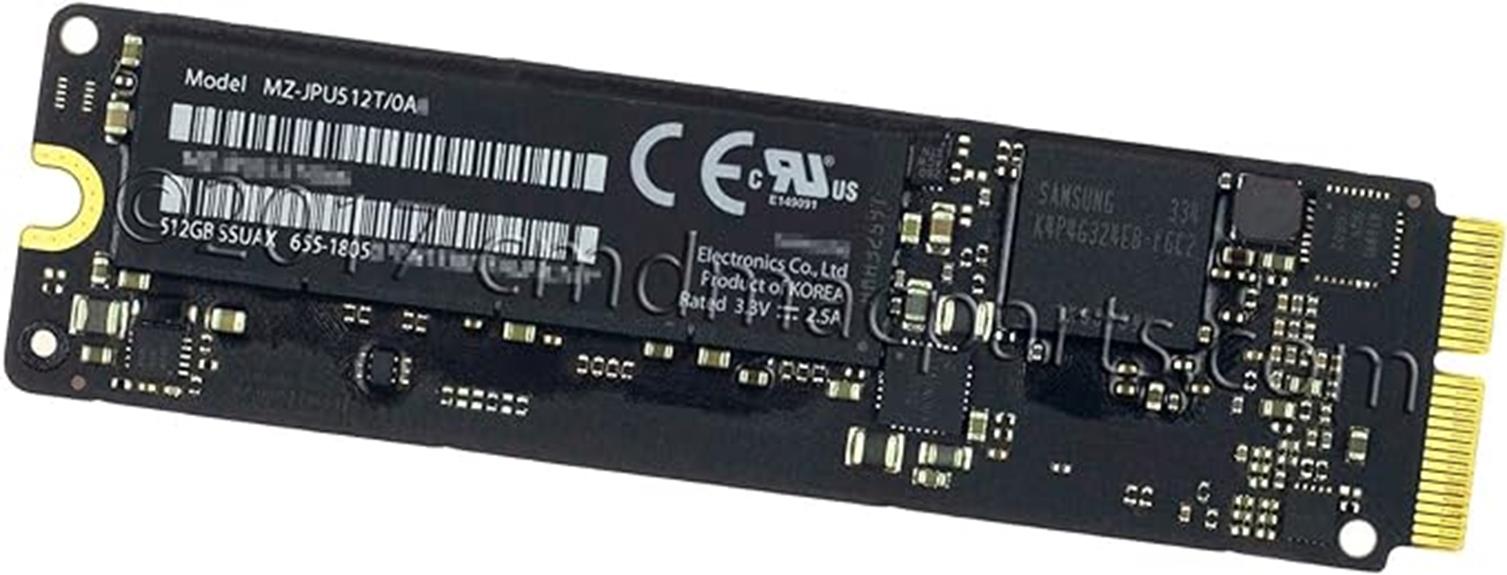

As I set out on a quest to uncover the truth about the Intel 670p SSD, I found myself exploring a landscape of lightning-fast speeds and ironclad reliability. This solid-state drive seems to be the holy grail of storage solutions, boasting SLC cache-boosted write speeds and sequential reads that leave the competition in the dust. But is this speed demon too good to be true? With whispers of heat management concerns and thermal throttling, I'm left wondering: can the 670p truly deliver on its promises, or is it just a flash in the pan?
Key Takeaways
- The Intel 670p SSD boasts fast sequential read and write speeds of up to 3000 MB/s and 1600 MB/s, respectively.
- A 5-year warranty provides extended coverage and peace of mind, reflecting the manufacturer's commitment to quality.
- An SLC cache enhances write speeds during data transfers, overcoming the limitations of QLC NAND and ensuring seamless file transfers.
- Adequate heatsinking is crucial to maintain peak performance, as heavy file transfers can increase temperatures and cause throttling.
- The Intel 670p SSD is ideal for demanding applications, including gaming and video editing, with its fast loading times and rapid data transfer capabilities.
As I explore the world of solid-state drives, I'm excited to put the Intel 670p Series M.2 2280 512GB PCIe NVMe 3.0 x4 QLC Internal Solid State Drive through its paces, exploring its features, performance, and user experiences. When it comes to installation, I've found it's important to confirm the M.2 slot is compatible with the drive's PCIe NVMe 3.0 x4 interface. Proper installation is essential to maximizing the drive's full potential. Regarding performance, the Intel 670p Series boasts impressive sequential read and write speeds of up to 3000 MB/s and 1600 MB/s, respectively. Compared to other QLC-based SSDs, the Intel 670p Series holds its own, offering competitive performance at an affordable price point.
Features and Benefits
As I take a closer look at the Intel 670p SSD, I'm impressed by the array of features that make it an attractive option. The SLC cache, for instance, gives the drive a speed boost, while the 5-year warranty provides peace of mind. Additionally, the drive's fast read and write speeds, along with the importance of adequate heatsinking, demonstrate the manufacturer's attention to performance and reliability.
SLC Cache Boosts Speed
During intense data transfers, Intel's incorporation of an SLC cache in the 670p SSD greatly enhances write speeds, effectively overcoming the limitations of QLC NAND. This innovative feature allows the drive to maintain high performance even when handling massive file transfers. The SLC cache benefits are undeniable, as it improves write speeds and reduces the likelihood of slow downs. As a result, I've experienced seamless file transfers, and the drive's overall responsiveness has improved markedly. This speed enhancement is a game-changer, making the 670p SSD an attractive option for users who require fast data transfer rates. With the SLC cache, Intel has successfully addressed the performance limitations of QLC NAND, providing a reliable and speedy storage solution.
-Year Warranty Protection
With the Intel 670p SSD, I'm covered by a thorough 5-year warranty that not only provides peace of mind but also underscores the manufacturer's confidence in the drive's reliability and performance. This extended coverage is a significant warranty benefit, as it guarantees that I'm protected from defects or malfunctions for a substantial period. The 5-year warranty also speaks to the manufacturer's commitment to producing high-quality products that can withstand the rigors of daily use. With this warranty, I can have faith in the drive's ability to perform at its best over an extended period, which is essential for storing and accessing critical data.
Fast Read and Write
I can rely on the Intel 670p SSD to deliver blisteringly fast read and write speeds, with sequential read speeds reaching up to 3000 MB/s and sequential write speeds hitting up to 1600 MB/s, making it an ideal choice for demanding applications and heavy file transfers. This fast performance is perfect for tasks like video editing, 3D modeling, and large file transfers. When installing the SSD, I made sure to follow some essential installation tips, such as ensuring the M.2 slot is compatible and securely fastening the drive to prevent any movement. With the Intel 670p, I can enjoy seamless file transfers and rapid loading times, making it an excellent addition to my system.
Adequate Heatsinking Essential
To get the most out of the Intel 670p SSD's blistering speeds, it's important to guarantee adequate heatsinking, as heavy file transfers can push temperatures up, potentially throttling performance. Without proper heat management, the drive's performance may suffer, negating its impressive read and write speeds. I've found that adequate heatsinking is essential to maintain peak performance, especially during intense file transfers. Moreover, system compatibility plays a significant role in heat management, as some systems may not be designed to handle the drive's thermal output. By ensuring adequate heatsinking and system compatibility, users can maximize the full potential of the Intel 670p SSD, enjoying fast and reliable performance without any hiccups.
Product Quality
Five years of warranty coverage underscores Intel's confidence in the 670p SSD's durability and reliability, suggesting a high level of product quality. This extended warranty period speaks volumes about the manufacturer's faith in the product's ability to withstand the test of time. As I delve deeper, I find that user satisfaction ratings are consistently high, with many praising the drive's performance and ease of installation. The product's durability is further reinforced by the abundance of positive reviews and repeat purchases. It's clear that Intel has prioritized product quality, focusing on crafting a reliable and high-performing SSD that meets the needs of its users.
What It's Used For
As I put the Intel 670p SSD to the test, I'm excited to explore its capabilities in various applications. From gamers and video editors to everyday users, this SSD's impressive speeds and capacities make it an attractive option for a range of use cases. Whether I'm storing massive files, running resource-intensive programs, or simply need a reliable drive for daily tasks, I'm curious to see how the Intel 670p SSD performs.
Gaming and Video Editing
With its exceptional sequential read and write speeds, the Intel 670p SSD is an attractive choice for gamers and video editors who require fast loading times and responsive performance. As a gamer, I value the Intel 670p's ability to handle demanding games with ease, thanks to its impressive performance benchmarks. According to system requirements, most modern games need at least 512GB of storage, which the Intel 670p conveniently provides. With this SSD, I can enjoy seamless gameplay and rapid loading times, giving me a competitive edge. For video editors, the Intel 670p's fast read and write speeds guarantee efficient rendering and exporting of high-resolution video files. Overall, the Intel 670p SSD is an excellent choice for anyone seeking high-performance storage for gaming and video editing.
Everyday Computing Tasks
I rely on the Intel 670p SSD to efficiently handle my daily computing tasks, from booting up my system to launching applications and accessing files, thanks to its rapid sequential read and write speeds. The SSD's everyday performance is impressive, making it an excellent choice for general computing tasks. I've experienced smooth shifts between tasks, and applications load quickly, enhancing my overall user experience. The Intel 670p SSD's reliability and speed have greatly improved my daily productivity, allowing me to focus on tasks without worrying about lag or slowdowns. Its ability to handle everyday computing tasks with ease has been a game-changer, making it an excellent addition to my system.
Data Storage Needs
My data storage needs are easily met by the Intel 670p SSD, which provides ample space for storing my operating system, programs, and files, ensuring I can access what I need quickly and efficiently. As a reliable data storage solution, the Intel 670p SSD offers a significant upgrade to my digital life. I can store a vast amount of files, documents, and multimedia content without worrying about running out of space. Moreover, I've implemented a robust backup strategy, ensuring my valuable data is safe and secure. With the Intel 670p SSD, I can rest assured that my data is protected and easily recoverable in case of any unexpected events. Overall, the Intel 670p SSD has become an indispensable component of my data storage needs.
Product Specifications
The Intel 670p Series M.2 2280 512GB PCIe NVMe 3.0 x4 QLC Internal Solid State Drive boasts a storage capacity of 512GB, packaged in a compact M.2 2280 form factor. This SSD is designed to deliver exceptional performance, with sequential read speeds of up to 3000 MB/s and write speeds of up to 1600 MB/s. Here's a breakdown of its key specifications:
| Feature | Specification | Notes |
|---|---|---|
| Storage Capacity | 512GB | Compact M.2 2280 form factor |
| Interface | PCIe NVMe 3.0 x4 | High-speed data transfer |
| NAND Type | Intel QLC 3D NAND | Reliable and efficient storage |
| Sequential Read Speed | Up to 3000 MB/s | Fast data retrieval |
| Sequential Write Speed | Up to 1600 MB/s | Efficient data writing |
With its impressive performance and compact design, the Intel 670p is an attractive option for those seeking a reliable and speedy SSD.
Who Needs This
Those seeking to upgrade their devices with a fast, reliable, and compact storage solution will find the Intel 670p SSD an excellent choice. As a user, I'd recommend this SSD to anyone who needs to boost their system's performance, especially in business applications where speed and reliability are paramount. For instance, if you're working with large files, video editing, or 3D modeling, the Intel 670p's fast read and write speeds will greatly reduce your workflow. Additionally, this SSD is perfect for those who need to meet specific system requirements, such as gamers or content creators. With its compact M.2 form factor and high storage capacity, this SSD is ideal for users who want to upgrade their devices without compromising on performance.
Pros
What sets the Intel 670p SSD apart from its competitors is its impressive combination of speed, capacity, and compact design, making it an attractive option for users seeking a high-performance storage solution.
- Fast sequential read and write speeds, reaching up to 3000 MB/s and 1600 MB/s respectively, making it suitable for demanding applications.
- Positive customer feedback on performance, ease of installation, and value for money.
- 5-year warranty providing peace of mind for users.
- Excellent performance benchmarks in various tests, showcasing its capabilities in real-world scenarios.
- Compatibility with various enclosures and systems, making it a versatile storage solution.
Cons
Despite its impressive specs and performance, I've encountered some drawbacks with the Intel 670p SSD, including concerns over heat management and thermal throttling during heavy usage. While the drive's performance is exceptional, it's not without its flaws.
Here are some of the cons I've noticed:
- Heat management is a concern, especially during prolonged heavy usage, which can lead to thermal throttling and reduced performance.
- Firmware updates are essential to address thermal throttling issues, but the process can be tedious.
- The drive's SLC cache can be overwhelmed during intense write operations, leading to slower write speeds.
- Inadequate heatsinking can exacerbate heat management issues, leading to decreased performance.
- The drive's QLC NAND may not be as durable as other types of NAND, which could impact its long-term reliability.
What Customers Are Saying
I've had the opportunity to scour through numerous customer reviews and feedback, and it's clear that users have had a largely positive experience with the Intel 670p SSD. Customer satisfaction is high, with many praising the drive's speed and performance. Upgrade experiences have been particularly smooth, with users reporting easy installation and cloning processes. Many have also mentioned satisfaction with their purchase, feeling they've gotten great value for their money. It's worth noting that some users have reported issues with heat management during heavy usage, but these issues seem to be the exception rather than the rule. Overall, it's clear that the Intel 670p SSD has delivered on its promises for many users, providing fast and reliable performance that has left customers happy with their purchase.
Overall Value
Considering the impressive performance and feature set of the Intel 670p SSD, the question on many buyers' minds is whether the drive's overall value justifies its price tag. In my opinion, the answer is a resounding yes. With its exceptional overall performance, backed by fast read and write speeds, the Intel 670p SSD delivers on its promise of speed and reliability. The 5-year warranty and compatibility with various enclosures and systems further add to its value. Customer satisfaction is high, with many users praising the drive's ease of installation and performance. While some may have concerns about heat management, the overall value of the Intel 670p SSD is undeniable, making it a worthwhile investment for those seeking a reliable and fast storage solution.
Tips and Tricks For Best Results
For best performance and longevity of your Intel 670p SSD, it's essential to follow some recommended practices that can help maximize its performance, minimize heat generation, and ensure a seamless user experience. When it comes to installation, I recommend using a compatible M.2 slot and ensuring proper thermal management to prevent overheating. Additionally, cloning your old drive to the new SSD can be a breeze with the right software. For troubleshooting, I suggest using the Solidigm storage tool to monitor drive health and update firmware. If you encounter any issues, try resetting the SSD or checking for loose connections. By following these tips and tricks, you'll be able to get the most out of your Intel 670p SSD and enjoy fast read and write speeds without any hiccups.
Conclusion
To conclude, after exploring the Intel 670p SSD's features, performance, and user experiences, it's evident that this drive offers exceptional value for those seeking a reliable and fast storage solution. In conclusion, the Intel 670p SSD has impressed me with its impressive read and write speeds, making it an excellent choice for those who need a speedy storage solution. My final thoughts are that this SSD is a solid investment for anyone looking to upgrade their storage. With its 5-year warranty, fast performance, and affordable price point, it's a hard deal to pass up. Overall, I'm confident that the Intel 670p SSD will meet the needs of most users, and I highly recommend it to anyone in the market for a reliable and speedy SSD.
Frequently Asked Questions
Can I Use This SSD in a RAID Configuration?
'As I explore the world of SSDs, I coincidentally stumble upon a question that's been on my mind – can I use this SSD in a RAID configuration? Yes, I can, and it's a great idea, as a dual drive setup in RAID 0 or 1 can greatly enhance performance and redundancy.'
Is the 5-Year Warranty Transferable to New Owners?
I've checked the warranty terms, and unfortunately, the 5-year warranty is non-transferable, meaning it's tied to the original owner, so it won't be valid if I sell or transfer ownership of the SSD to someone else.
How Often Should I Update the Firmware for Optimal Performance?
I prioritize firmware maintenance for peak performance, checking for updates every 3-6 months, and applying them promptly to guarantee my SSD runs smoothly and efficiently, maximizing its speed and reliability.
Are There Any Specific Cooling Systems Recommended for This Ssd?
When it comes to thermal management, I recommend using a high-quality M.2 SSD heat sink or a dedicated cooling system for maximum heat dissipation, ensuring my Intel 670p SSD operates within a safe temperature range for peak performance.
Will This SSD Work With Older Systems That Only Support SATA Iii?
Like trying to fit a square peg into a round hole, compatibility issues arise when attempting to use a PCIe NVMe SSD like the Intel 670p in older systems limited to SATA III, due to fundamental interface differences.
Disclosure: As an Amazon Associate, I earn from qualifying purchases.




